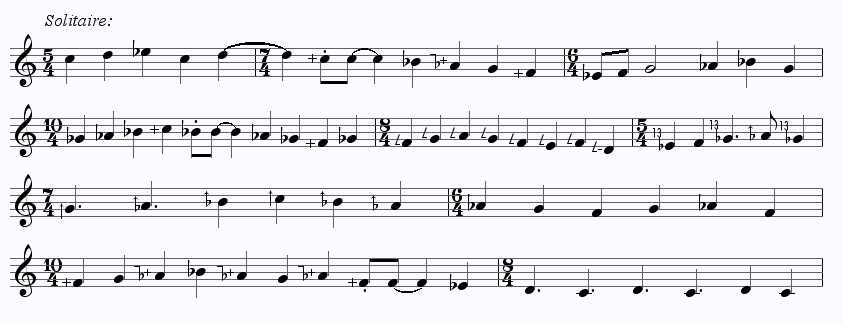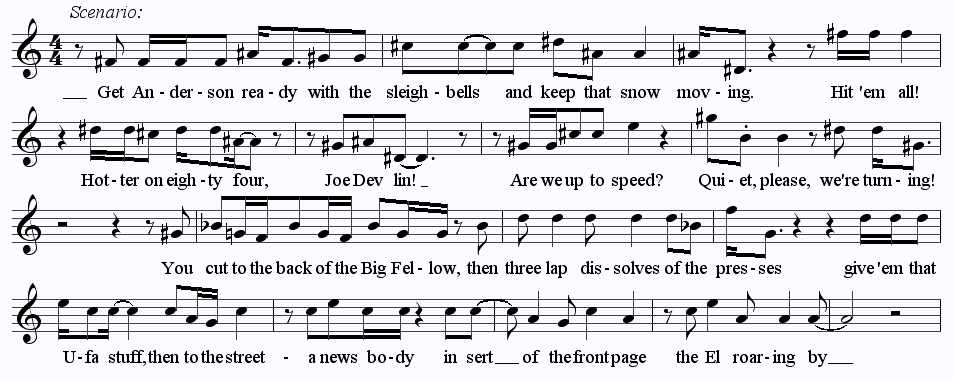I've written a tremendous amount about postminimalist music. Speaking broadly, the music I've written about suggests that minimalism's primary legacy is in the area of texture. Many postminimalist pieces seem to be sustained exercises in texture, often for mixed chamber groups whose disparate timbres are expertly woven into vibrant continua of interlocking lines and hocketing rhythms. Melody is not absent, but tends to be de-emphasized, often using a few pitches in continually varying rhythmic placements determined by whatever process is going on. It's a lovely body of music. I am intentionally going to refrain from examples or composers' names here, because I love this music, and am friends with many of its creators - but I am going to distinguish my own music from this tradition, and I would not want the composers to feel in any way singled out or disparaged.
It has always seemed to me that melody, rhythm, and harmony are primary aspects of music, and texture and timbre (this latter rarely dwelt on much in postminimalist music, but quite prominent in spectral music) are secondary. I think this is just the natural order of things; you may argue that experience and training could alter our perceptions in this respect, and I'll agree that could be possible temporarily and in limited circumstances, but I think the natural order will quickly reassert itself with each new listener or generation of listeners. Melody, rhythm, and harmony are what naive listeners perceive directly; texture and timbre are areas in which composers show their craft and their subtlety.
To foreground texture (as much postminimalist music does) or timbre (as in spectral music and much electronic music) is to put out in front those subtle ways in which composers demonstrate their craft. It is a continuation of the 20th-century trend toward abstraction. Texture and timbre are difficult aspects for naive listeners to appreciate directly; they are for the connoisseur. Given a musical surface of texture and timbre, lacking differentiated melody, harmony, or rhythm, the naive listener will feel that some focal point is missing. (And I do not mean to imply that much postminimalist music can be charactized this way - a striking rhythm is rarely absent - I just need that theoretical extreme to illustrate my point.) Texture and timbre are difficult to internalize mentally, to represent in memory.
By contrast, melody, rhythm, and harmony provide foci of listener identification. Rhythm gives music its infectious energy. Harmony gathers the disparate elements of a texture to create the power of a collective impression. And melody is the personable aspect of music, the memorable, and the vulnerable. Vulnerable, because unlike a texture or timbre, a melody can fail if there's a note out of place. It has to be judged painstakingly and minutely by the composer, because it will be so judged by the listener. And unlike with a texture or timbre, the listener has the acumen to listen to a melody and say, "ThatŐs not quite right," or, "Ooh, that hit the spot." Writing melodies, you put your soul on the line. I think the listener appreciates that.
As Lou Harrison told Bill Duckworth in an interview, "Your take-home pay from a piece of music is a melody, a tune -- and that's it. How do we recollect almost anything we know? It's the tune. So I write them." I canŐt say I was influenced by Lou in that respect, because I had arrived at the idea before I knew much of his music, but he and I were blood-brothers on that point.
And so I write tunes. They are usually the foci of my music, even in works for "unpitched" percussion. Here are a handful of examples from among dozens I could quote:
Why do I bring this up? Not to assert that I am right and my postminimalist brethren are wrong - but to make clear that I am aware how anomalous my music is in the postminimalist landscape, and that what I do, I do deliberately. My music may sound naive, but I do not write it naively. I do not write melodies because I have somehow misunderstood or insufficiently assimilated Xenakis and Glass and Berio and Prt and Feldman and Ligeti and Reich and Niblock and Branca, but because I want the embodiment of what is new in my music to have a wider communicative reach than that music (much of which I love dearly) often has. I am braced for reviews of the Volharding "Minimalists" CD to charge that my piano concerto Sunken City on that CD isn't really minimalist - in fact, the liner note writer felt it necessary to apologize for the fact. But I do feel that my music is postminimalist, even second-generation minimalist.
To write music of evolving and nonrepetitive textures is a logical next step from minimalism, but no sooner had I considered that possibility, back in the 1970s, than I found it insufficiently rewarding. I couldn't have been more than 20 the day it first occurred to me that my melodic sense was the most distinctive part of my music. The moment I imagined moving beyond classic minimalism I began wanting to do so via melody. The way I generate my melodies has its roots in minimalism. My melodies are harmonically supported to give them a feeling of logical rightness; another way of saying that is that the melodies are generated from the voice-leading peculiarities of the harmonic progressions, so that the melodies clarify, amplify, aspects of the harmonic criteria that might otherwise remain unnoticed. I could disavow originality entirely and say that the technique comes from the "Bed" scene of Glass's Einstein on the Beach. The melodies create an illusion of variety over the permutational scheme controlling the limited harmonies. The rhythmic aspect varies more from piece to piece, but the melody usually gives contour to that aspect as well.
What recently got me thinking about these issues is that a friend who likes my music mentioned that my music is difficult to talk about, because we composers are so out of the habit of talking about melody that we no longer think to refer to it. I do feel that my music is more often misperceived by composers and new-music aficionados than it is by naive listeners. Music is supposed to show its seriousness today (even when it's pretty, as much postminimalist music is) by being abstract, distanced from the listener, invulnerable; I flout these mandates. My reliance on melody and harmony may seem old-fashioned - but it is calculated, and is for me the foil for my underlying rhythmic and formal originality. (After all, most of the melodies above look pretty unconventional, don't they? Though I picked these as among my favorites because they are all attractively natural in context.) Sometimes I borrow ragtime harmonies, Romantic harmonies, bebop harmonies - because I need harmony for my purposes, and it is characteristic of postminimalist technique that any repertoire of harmonies will serve. The major hurdle of my career is that distribution of new music today is so generally controlled by composers, the very group who least seem to understand what I'm doing - because I refuse to satisfy the profession's general preference for abstractness, distancing, and impersonality.
I don't believe any other composer today has written as many words about the music of other living composers as I have, and I am widely acknowledged to write about the field with some understanding. It would be odd indeed, then, if the rationales behind my own composing lacked sophistication or cultural context - but I do sometimes find my music described as if the writer suspects this is the case. (Since I "started out as a music critic," or so they think - after getting three degrees in composition - I must not really understand how music works.) Every composer places his or her bets on what musical methods will pay off in the long run; I've placed mine on the primacy of melody for articulating and humanizing postminimalist rhythm and process. Anyone can think I've placed my bets unwisely - but I refuse to have anyone think I've placed them without being well aware of the implications and alternatives. You can like or not like what I'm doing, but don't imagine that I don't know what I'm doing.
November, 2009
Copyright 2009 by Kyle Gann
Return to the Kyle Gann Home Page
If you feel moved to reply to any of this, e-mail me at kgann@earthlink.net










